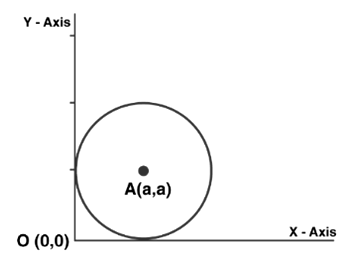
Find the equation of the circle which touches both axes in the first quadrant and whose radius is a
A )$\quad x^{2}+y^{2}-2 a x-2 a y+a^{2}=0$
B )$\quad x^{2}+y^{2}-2 a x+2 a y-a^{2}=0$
C )$\quad x^{2}+y^{2}+2 a x-2 a y+a^{2}=0$
D ) None of the above
Answer
219k+ views
Hint:We have the general equation of circle. And it is given that the circle touches both axes in the first quadrant. So we can find the general equation of the given circle by substituting the a value. The radius of a circle is one of its most important features It is the separation between a point on a circle's edge and its center.
Complete step by step Solution:
Given,
In the first quadrant, a circle with radius a contacts both axes, hence its center will be $(a, a)$.

Therefore the required equation is
$\Rightarrow(x-a)^{2}+(y-a)^{2}=a^{2}$
$\Rightarrow x^{2}+a^{2}-2 a x+y^{2}+a^{2}-2 a y=a^{2}$
$\Rightarrow x^{2}+y^{2}-2 a x-2 a y+2 a^{2}-a^{2}=0$
$\Rightarrow {{x}^{2}}+{{y}^{2}}-2ax-2ay+{{a}^{2}}=0$
Therefore, the correct option is A.
Additional information:
The radius of a circle is the length of the straight line that connects the center to any point on its circumference. Because a circle's circumference can contain an endless number of points, a circle can have more than one radius. This indicates that a circle has an endless number of radii and that each radius is equally spaced from the circle's center. When the radius's length varies, the circle's size also changes.
Note: The equation for a circle has the generic form: ${{x}^{2}}+{{y}^{2}}+2gx+2fy+c=0$. The coordinates of the circle's center and radius are found using this general form, where g, f, and c are constants. The general form of the equation of a circle makes it difficult to identify any significant properties about any specific circle, in contrast to the standard form, which is simpler to comprehend. So, to quickly change from the generic form to the standard form, we will use the completing square formula.
Complete step by step Solution:
Given,
In the first quadrant, a circle with radius a contacts both axes, hence its center will be $(a, a)$.

Therefore the required equation is
$\Rightarrow(x-a)^{2}+(y-a)^{2}=a^{2}$
$\Rightarrow x^{2}+a^{2}-2 a x+y^{2}+a^{2}-2 a y=a^{2}$
$\Rightarrow x^{2}+y^{2}-2 a x-2 a y+2 a^{2}-a^{2}=0$
$\Rightarrow {{x}^{2}}+{{y}^{2}}-2ax-2ay+{{a}^{2}}=0$
Therefore, the correct option is A.
Additional information:
The radius of a circle is the length of the straight line that connects the center to any point on its circumference. Because a circle's circumference can contain an endless number of points, a circle can have more than one radius. This indicates that a circle has an endless number of radii and that each radius is equally spaced from the circle's center. When the radius's length varies, the circle's size also changes.
Note: The equation for a circle has the generic form: ${{x}^{2}}+{{y}^{2}}+2gx+2fy+c=0$. The coordinates of the circle's center and radius are found using this general form, where g, f, and c are constants. The general form of the equation of a circle makes it difficult to identify any significant properties about any specific circle, in contrast to the standard form, which is simpler to comprehend. So, to quickly change from the generic form to the standard form, we will use the completing square formula.
Recently Updated Pages
The maximum number of equivalence relations on the-class-11-maths-JEE_Main

A train is going from London to Cambridge stops at class 11 maths JEE_Main

Find the reminder when 798 is divided by 5 class 11 maths JEE_Main

An aeroplane left 50 minutes later than its schedu-class-11-maths-JEE_Main

A man on the top of a vertical observation tower o-class-11-maths-JEE_Main

In an election there are 8 candidates out of which class 11 maths JEE_Main

Trending doubts
JEE Main 2026: Application Form Open, Exam Dates, Syllabus, Eligibility & Question Papers

Derivation of Equation of Trajectory Explained for Students

Hybridisation in Chemistry – Concept, Types & Applications

Understanding the Angle of Deviation in a Prism

Understanding Collisions: Types and Examples for Students

Understanding Atomic Structure for Beginners

Other Pages
JEE Advanced Marks vs Ranks 2025: Understanding Category-wise Qualifying Marks and Previous Year Cut-offs

NCERT Solutions for Class 11 Maths Chapter 10 Conic Sections

NCERT Solutions for Class 11 Maths Chapter 9 Straight Lines

NCERT Solutions For Class 11 Maths Chapter 8 Sequences And Series

How to Convert a Galvanometer into an Ammeter or Voltmeter

NCERT Solutions For Class 11 Maths Chapter 12 Limits And Derivatives




